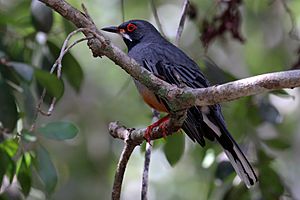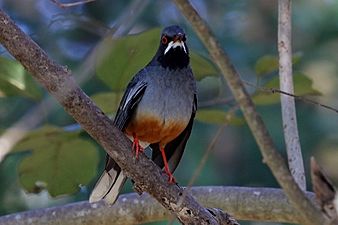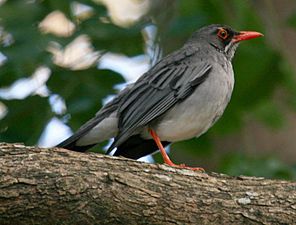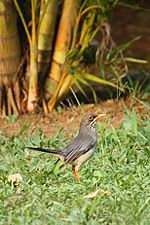Red-legged thrush facts for kids
Quick facts for kids Red-legged thrush |
|
|---|---|
 |
|
| T. p. rubripes Zapata National park, Cuba |
|
| Conservation status | |
| Scientific classification |
The red-legged thrush (Turdus plumbeus) is a type of bird that lives in the Caribbean. It belongs to the Turdidae family, which includes many thrushes. This bird is known for its bright orange-red legs, bill, and eye ring.
You can find the red-legged thrush in several Caribbean countries. These include Bahamas, Cayman Brac, Cuba, Dominica, Hispaniola (which is made up of the Dominican Republic and Haiti), and Puerto Rico. In the past, it also lived on the Swan Islands, Honduras. In Puerto Rico, people call this bird zorzal de patas coloradas.
Contents
Where Red-legged Thrushes Live
Red-legged thrushes like to live in different kinds of forests. Their favorite places are warm, dry forests or moist lowland forests in tropical areas. They also live in moist montane forests, which are forests found on mountains. Even if a forest has been changed a lot by humans, these birds can still live there.
Many people think of the red-legged thrush as the Caribbean version of the American robin. This is because they act in similar ways. For example, both birds often visit gardens and lawns, looking for food.
What Red-legged Thrushes Look Like
The red-legged thrush is a fairly large bird. It is about 27 cm (11 in) long, which is about the length of a ruler. It weighs around 75 g (2.6 oz). This is about the weight of a small apple.
Most of its body is bluish-grey on top and a lighter grey underneath. Its throat has a striped look with white and black markings. The most striking features are its bright orange-red legs, bill (beak), and the ring around its eyes. The exact colors can be a bit different depending on which type of red-legged thrush it is.
Different Types of Red-legged Thrushes
Scientists have found six different types, or subspecies, of the red-legged thrush. Each subspecies has slight differences in its looks or where it lives.
- T. p. plumbeus – This is the main type, found in the northern Bahamas islands.
- T. p. schistaceus – This type lives in eastern Cuba. It has a beige-orange color on its lower sides and belly. Its bill is dark red with a dusky tip.
- T. p. rubripes – You can find this type in central and western Cuba and on Isle of Pines. It has more white on its throat and cheeks. It also has orange on its lower sides, belly, and vent area.
- T. p. coryi – This subspecies lives in the Cayman Islands. It is paler and has less orange on its underside compared to T. p. rubripes.
- T. p. ardosiaceus – This type is found on Hispaniola (in the Dominican Republic and Haiti) and Puerto Rico. It has darker underparts and less white under its tail.
- T. p. albiventris – This subspecies lives on Dominica. It has an orange bill, feet, and eye ring.
-
T. p. rubripes
Cuba -
T. p. ardosiaceus
Puerto Rico -
T. p. albiventris
Dominica
What Red-legged Thrushes Eat
Red-legged thrushes mostly eat fruits. However, about one-third of their diet comes from animals. They eat many kinds of insects, such as caterpillars, beetles, ants, crickets, and wasps. Sometimes, they also eat snails, frogs, lizards, and even the eggs of other birds.
See also
 In Spanish: Zorzal patirrojo para niños
In Spanish: Zorzal patirrojo para niños





